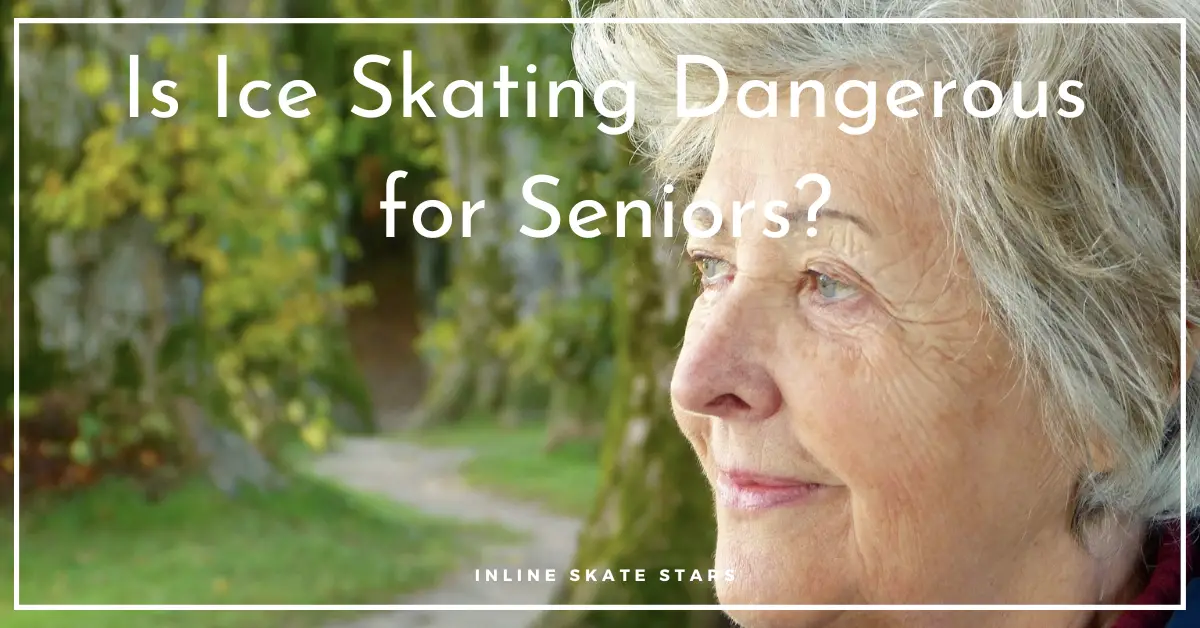Ice skating is fun and a great way to stay active for everyone despite age. But some seniors may not be good candidates for ice skating because of their age and health.
Ice skating can cause fractures, sprains, and even head injuries in younger individuals.
In seniors, the risk of injury is higher because they are more likely to have less muscle strength and flexibility.
I cover details about this subject in the rest of this guide, and you don’t want to miss out!
Is ice skating dangerous for seniors?
Ice skating is dangerous for seniors since they’re more likely to fall and suffer the most common injuries like ankle sprains, head injuries, ACL tears, lacerations, and hand and wrist injuries.
Seniors are at more risk when skating without proper gear and clothing for ice skating and expert supervision.
Below I elaborate on why ice skating can be dangerous for seniors;
1. Seniors lack proper body coordination, and their balance is less stable
Seniors are more likely to suffer falls when skating because they have less muscle strength and balance.
According to a WebMD report, the condition known as Sarcopenia is caused by old age.
This condition sees people lose as much as 3% to 5% of their muscle mass, especially core muscles, each decade after age 30.
Seniors suffering from this condition will undoubtedly have less muscle strength and are likelier to fall while ice skating since the sport is physically demanding.
2. Ice skating rink surfaces can be slippery
Elderly skaters are likelier to fall when the ice surface is wet or icy because they don’t have as much grip and balance.
It’s a common problem using poorly sharpened blades that don’t cut into the ice.
This makes it more difficult for them to stay on their feet and prevent falls.
3. Skating without proper attire or gear can significantly increase the risk of injury
Since seniors cannot withstand cold temperatures, ice skating can be dangerous if they don’t wear the appropriate clothing.
Lack of proper attire like a coat or gloves increases the risk of frostbite and injuries from slipping on ice.
Seniors need to consult with a skating coach before starting any skater activity to ensure they’re properly equipped and supervised so that they won’t suffer an injury.
4. Failing to pay attention while on the ice
Seniors are more likely to become distracted while ice skating and not watch where they’re going.
According to a study by Havard Health, seniors have trouble associating movement with real-world stimuli due to the natural loss of receptors and neurons and can easily lose focus.
This makes them more susceptible to getting injured since they won’t be able to sense when they’re about to fall.
What are the risks of ice skating for seniors?
Below are the injuries and risks seniors are likely to suffer or experience from ice skating;
Ice skate blade cuts/lacerations
Ice skate blades can easily cut skin if not correctly sharpened, which increases the risk of getting cuts. Seniors may also sustain cut injuries from falling on the cold hard ice surface.
Knee injuries/leg pain
Seniors’ lack of experience with cartilage loss makes their knees more susceptible to pain when skating on ice.
They are also more likely to suffer from frozen toes and numbness in their feet due to ice skate injuries.
Frostbite
Frostbite is a common injury among seniors, mainly if they don’t wear proper clothing while skating.
Frozen skin can easily be pulled off the body, resulting in painful blisters and even tissue necrosis (death of underlying cells).
Back injuries
Seniors are more likely to suffer from back fractures ice skating because of the added stress on their spine.
It’s a primary risk, especially for people that skate longer than necessary.
Roll over
Seniors are more likely to roll over when ice skating, which can lead to fractures and head injuries.
Ankle sprains and fractures
Seniors are at a greater risk of ankle sprains and fractures when ice skating because their joints tend to be less flexible.
The ankle injuries are likely to damage the peroneal and tibialis anterior muscles.
Head injuries
Senior ice skaters are more likely to suffer from head injuries, such as concussions when ice skating because they may not be able to keep up with the faster skaters.
ACL tears
Senior ice skaters are likely to tear the anterior cruciate ligament (ACL) when skating because they tend to overuse the knee joints.
ACL injuries often require a lengthy rehabilitation process.
Hand and wrist injuries
Seniors can suffer from hand and wrist injuries when ice skating if they use their hands for balance.
They may also collide with other skaters or fall on ice, which can result in sprains and fractures.
Safety tips: How can seniors reduce their risk of injury while ice skating?
Seniors can reduce their risk of injury by following these safety tips:
- Wear skating protective equipment like a helmet when ice skating. This will protect your head from injuries such as concussions. Check on Amazon for some of the best options available on the market. Also, wear protective gear like knee pads to protect the knees from falls.
- Warm up before ice skating. Ensure you exercise for a few minutes and warm up your muscles to be ready when skating.
- Ice skate slowly so you get used to the ice and the skater’s movements.
- Skate in pairs or with a group of friends. Some seniors choose to skate in pairs or with friends, reducing their risk of getting injured while ice skating.
- If you fall behind, stay put until someone catches up with you; do not try to catch up by skating faster than the skater in front of you.
- Avoid skating on wet or slippery ice; this makes it difficult to stay upright and can lead to falls.
- Use a skating tour or ice rink that is designed for senior citizens. These facilities have ramps, rails, and other safety features to make the experience safer for them.
- Use a skating coach or class to learn the proper skating techniques. A skating coach can teach you how to avoid common injuries and improve your ice skating skills.
- If you experience any injuries while ice skating, stop skating and see a doctor.
- Choose an appropriate ice skating discipline for you. Depending on your strength, you can opt for figure skating, speed, hockey, or recreational ice skating.
The benefits of ice skating for seniors
Despite the challenges associated with ice skating, it has many benefits for seniors. Below are the benefits of ice skating for seniors;
- Ice skating can help seniors improve their mobility and balance.
- It strengthens bones and muscles, reducing the risk of injuries in other areas of life.
- It is a great way to keep your mind active and entertained, especially during cold winter months like January when days tend to drag on longer than usual!
- Ice skating helps seniors stay physically fit; it is a low-impact sport that doesn’t require much equipment or training time. It burns between 640 and 850 calories per hour of ice skating.
- It helps seniors socialize and make new friends.
- It’s a great way to stay active and learn new skills, whether you’re looking for a recreational activity or something that can prepare you for retirement.
- Ice skating is affordable – most beginner skate classes are priced at $5-$15 per class.
- Ice skating can help seniors reduce stress, manage mood swings, and improve their overall mood.
- Ice skating is a great way to connect with nature, whether you skate on a frozen outdoor rink or in an indoor skater palace.
Is ice skating dangerous for seniors? Final thoughts
Ice skating may be perfect for you if you are a beginner skater or looking for a new and exciting activity to keep you busy during the winter months.
However, if ice skating isn’t your thing – or if injuries prohibit you from participating in traditional skating disciplines such as figure skating – there are other options available to seniors.
These include speed skating and hockey skating, both of which can be enjoyable and rewarding activities.
Importantly, you must take precautions and be wary of the risks, such as ankle sprains and fractures, head injuries, ACL tears, lacerations, frostbite/hypothermia, and hand and wrist injuries.
It helps to sign up for ice skating lessons, primarily if you’ve never skated.
Lastly, you may consider other sports like roller skating, walking, Nordic skiing, or swimming if ice skating isn’t your thing!




